Apr 04, 2005
Bianco-Valente: Neurovisions of the post-human age
Contemporary art is exploring the link between mind, brain and technology. Artists are scientists who experiment reality in a different way. They don't use the language of maths and physics, but the universal language of sensory experiences. There are concepts that cannot be expressed using numbers. For example, how would one represent the infinite complexity of the relationship between the mind and the brain? And how to describe the invisible co-evolution between natural and artificial, between biological and technological networks?

Bianco and Valente, two artists working in Neaple (Italy) propose an original answer to these questions. The focus of their work is "on perception phenomenons and brain dynamism that enable us to retain the memories of our experiences and perceive mind images, through which we can conceive an evolving reproduction of the external reality A very fascinating subject for us is the body-mind duality:  a flesh organic structure, finite and dependent on space and time that carries about the mind, a spontaneous phenomenon without visible boundaries, totally free and self-referential. We search for boundaries of this immaterial space living into the cerebral convolutions, trying to understand if and where it is possible to locate a point of contact linking indivisibly the two domains, the material and the immaterial"
a flesh organic structure, finite and dependent on space and time that carries about the mind, a spontaneous phenomenon without visible boundaries, totally free and self-referential. We search for boundaries of this immaterial space living into the cerebral convolutions, trying to understand if and where it is possible to locate a point of contact linking indivisibly the two domains, the material and the immaterial"

More to explore
Bianco-Valente Web site (only Italian, but with a few English articles about their work)
18:41 Posted in Cyberart | Permalink | Comments (0)
Virtual reality for disabled individuals
From the "Presence" listserv
By ERIN BELL
September 23, 2004
Special to The Globe and Mail
Anyone who's used Sony's EyeToy for the PlayStation 2 console knows how much fun it can be to put yourself into a video game with the help of a camera. More advanced technology developed in Canada is being used to help people with special needs learn skills and experience things that used to be beyond their reach.
The technology comes from a partnership between integrator Xperiential Learning Solutions Inc. and Toronto developer Jestertek Inc. (formerly the Vivid Group), whose virtual reality systems have been installed in places ranging from museums and science centres to the hockey and basketball halls of fame.
The pair's Experiential Learning Product Suite is aimed at people with physical, mental or behavioural disabilities.
Xperiential's founder, Theo D'Hollander, has a son with autism and relatives who suffer from cerebral palsy and Down syndrome. "It made me realize that this whole area [of technology for people with disabilities] is almost like a generation behind, it's in the industrial age when the rest of the world is in the Internet age," he said. "Today's technology is great for things like information gathering, but it has actually created more distance between people with disabilities and the life or job opportunities they need. The answer is to use technology to help create new experiences for them."
Like Sony's EyeToy, the Experiential Learning Product Suite uses cameras to capture a person's image and project it onto a monitor or large screen, combining it in real-time with the computer-generated action. The player can participate in virtual reality scenarios such as snowboarding, soccer, boxing, racing, and even mountain climbing, controlling the action by moving parts of their body. It's there the similarities cease, however.
Using cameras that capture at least 30 frames a second and hardware much more powerful than a game console, the suite can adapt to a player's physical characteristics and abilities.
Sensitivity, speed and range of motion are adjustable, allowing people to control programs with tiny gestures -- from a shrug to a toe-twitch -- letting a bedridden person see what it's like to ride a horse, or someone without the use of their hands play a virtual musical instrument.
The profile for each user can be fine-tuned as their mobility or skills improve. The partners are also working on a way to allow people to compete or collaborate on-line.
"It's very much a motivational experience for the kids or adults with disabilities who use the system," Jestertek president Vincent John Vincent said.
"Children with cognitive disabilities have short attention spans,"Mr. D'Hollander added. "With these programs, they're engaged by the games and music. There's something enticing about seeing themselves on television, and the idea that they're inside a computer game."
A study by the University of Ottawa is looking at ways to use the suite to make children's home-exercise rehabilitation programs more engaging.
"This gives people, especially those with some cognitive impairments or disabilities, the opportunity to have an experience that could not be possible otherwise," explained Dr. Heidi Seistrup, associate professor in the University's School of Rehabilitation Sciences.
"For example, they could play volleyball even though they're in a wheelchair, just by moving their fingers. The environment can be tweaked to allow someone with a very limited range of motion to play against someone who has a full range of motion. You put them on a level playing field, which you can't do in real life very easily."
In other cases, the suite is used to teach life skills. There are modules that can train people to sort a load of laundry, teach basic traffic safety, or show how to serve customers in a doughnut shop.
The system can be a social behaviour coach, too, Mr.
D'Hollander said. "Having a child with autism go to a family gathering at Christmas or go into a crowded mall is a big issue, because the initial encounter is so intense they can't handle it.
We can create a tape of family settings or a mall, and allow children to get used to it by interacting with [the virtual crowd] before they encounter the real thing, helping them over that social hurdle."
A site licence for the Experiential Learning Product Suite is $5,600 (including hardware for a single user and several dozen applications), and systems for additional users can be purchased for around $750 each. There's also a basic unit that sells for around $400, including about a dozen games, to deliver extra entertainment and exercise-related programs in a home setting.
Over the past several months, Xperiential has sold about 30 site licences to community living homes, rehabilitation centres and school boards across Ontario, as well as to customers in the United States and Europe, Mr. D'Hollander said.
A unit was recently installed at Community Living Oakville in Oakville, Ont. "We use it three times a week, and it's awesome,"
day service worker Kelleigh Melito said. "They love the dancing, racing and snowboarding. Because of our location, they can't get out much to go for walks, because there are no sidewalks; this is how they get their exercise."
Don Seymour, executive director of developmental services for Lambton County, Ont., said he hopes to use the virtual reality units in all the special needs homes under his jurisdiction.
"I watched a fellow we support who is in a wheelchair get in front of the camera and look at the screen, and all of a sudden realize he was in a racecar," Mr. Seymour said. "All he had to do was move his shoulders to race this car around a track. For a person who has limited mobility with their arms or legs, to be able to steer a racecar on a big screen was incredible."
"You hear about this stuff a dozen times in a year, and then to actually find something that has immediate flexibility to our folks is quite something," he added.
17:50 Posted in Cybertherapy | Permalink | Comments (0) | Tags: Positive Technology, virtual reality
New article about Presence published on Nature!
Maria V. Sanchez-Vives and Mel Slater have published a review article entitled "From Presence to Consciousness through Virtual Reality" on the prestigious journal Nature Neuroscience (ASI impact factor 2003: 27.007).

In this article, the authors argue that presence - the sense of "being there" perceived during the exploration of a virtual environment - is worthy of study by neuroscientists, and that it might aid the study of perception and consciousness.
Maria V. Sanchez-Vives, Mel Slater, From Presence to Consciousness through Virtual Reality, Nature Reviews Neuroscience 6, 332-339 (2005); doi:10.1038/nrn1651
12:15 Posted in Telepresence & virtual presence | Permalink | Comments (0) | Tags: Positive Technology, Presence
Mar 31, 2005
Biofeedback - improve health using signals from your own body
Biofeedback is a treatment technique in which people are trained to improve their health
by using signals from their own bodies. Physical therapists use biofeedback to help stroke
victims regain movement in paralyzed muscles. Psychologists use it to help tense and
anxious clients learn to relax. Specialists in many different fields use biofeedback to help
their patients cope with pain.
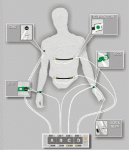 Research has demonstrated that biofeedback can help in the treatment of many diseases and painful conditions. It has shown that we have more control over so-called involuntary bodily function than we once though possible. But it has also shown that nature limits the extent of such control. Scientists are now trying to determine just how much voluntary control we can exert.
Research has demonstrated that biofeedback can help in the treatment of many diseases and painful conditions. It has shown that we have more control over so-called involuntary bodily function than we once though possible. But it has also shown that nature limits the extent of such control. Scientists are now trying to determine just how much voluntary control we can exert.
Clinical biofeedback techniques that grew out of the early laboratory procedures are now
widely used to treat an ever-lengthening list of conditions. These include:
·Migraine headaches, tension headaches, and many other types of pain
·Disorders of the digestive system
·High blood pressure and its opposite, low blood pressure
·Cardiac arrhythmias (abnormalities, sometimes dangerous, in the rhythm of the heartbeat)
·Raynaud's disease (a circulatory disorder that causes uncomfortably cold hands)
·Epilepsy
·Paralysis and other movement disorders
Low-cost biofeedback devices and products
ProComp Infiniti
Powerful 8 channel encoder provides real-time biofeedback and data acquisition in any clinical setting.

The Journey to Wild Divine
Learn to relax while playing this immersive new biofeedback videogame. Take a deep breath...

RESPeRATE
RESPeRATE is the only FDA-cleared, non-drug, medical device clinically proven to lower high blood pressure with no side effects.

Freeze-Framer
You'll appreciate all you can learn about the power of your heart. It's also just plain fun to play the games while you learn.

Mini C2+
This tiny 6 channel unit is an affordable, powerful multi-modality biofeedback system.

More to explore
Biofeedback Foundation of Europe
The Association for Applied Psychophysiology and Biofeedback
Society for the Study of Neuronal Regulation
The Biofeedback Certification Institute of America
13:35 Posted in Biofeedback & neurofeedback | Permalink | Comments (0) | Tags: Positive Technology, Biofeedback
Mar 29, 2005
Captology: The science of Persuasive Technology
Can computers change what you think and do? Can they motivate you to stop smoking, persuade you to buy insurance, or convince you to join the Army?
The Stanford Persuasive Technology Lab, founded by BJ Fogg, an experimental psychologist, is trying to answer these questions. The lab creates insight into how computing products -- from websites to mobile phone software -- can be designed to change what people believe and what they do.
Like human persuaders, persuasive interactive technologies can bring about positive changes in many domains, including health, business, safety, and education. With such ends in mind, we are creating a body of expertise in the design, theory, and analysis of persuasive technologies, an area called "captology."
This is how Fogg describes the key concepts of his vision:
"Captology is the study of computers as persuasive technologies. This includes the design, research, and analysis of interactive computing products created for the purpose of changing people's attitudes or behaviors. As the graphic shows, captology describes the area where computing technology and persuasion overlap.
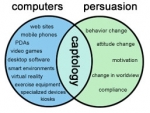
In the last few years we've seen this area grow quickly. Each week more computing products are designed to change what users think and do. We expect this trend to continue, especially as mobile phones become more capable of running third-party software applications.

We've identified over 100 uses for persuasive technology. Hundreds of other uses exist. Whenever there is a need to change what people believe or how they behave, persuasive technology may very well play a role"
More to explore
The web site of the Lab: http://captology.stanford.edu/
Fogg's book "Persuasive Technology"
18:15 Posted in Pervasive computing | Permalink | Comments (0) | Tags: Positive Technology, Ambient intelligence
Mar 24, 2005
Animator Makes Waves as Artist
From WIRED
by Rachel Metz
NEW YORK -- If beauty is in the eye of the beholder, oversized heads, alarmingly cherry-red lips, blotchy skin and sharp scroll-like claws are en vogue, at least in the digital world of artist Ray Caesar.
Caesar, a Toronto-based former animator and graphic artist for a children's hospital, is making waves in the world of pop art with his haunting, surreal digital prints, all produced just 18 months after he decided to pursue art full time. His works combine varied aspects of his life experiences, including the sorrow and inspiration brought by deaths of loved ones, and his years spent viewing photos of and working with abused, neglected and deformed children. His prints also benefit from Caesar's expertise with animation software and his exposure to animal research.

The prints are both grotesque and beautiful. As Caesar explains it, it's like facing something unpleasant with calm and looking beyond what you're viewing to see the beauty within.
Exhibits of Caesar's work are as real as it gets, because his art is created and manipulated digitally on his Dell 8300 computer and then printed on his massive, wide-format Epson 7600 printer. The "original" exists only on Caesar's hard drive and can be repositioned and changed at his whim. He uses the animation program Maya to compose his pieces.

A selection of Caesar's works were presented Saturday March 19, at the evening opening of his latest show, Hidden Doors and Secret Rooms, at the Jonathan LeVine Gallery in New York City's Chelsea neighborhood.
The show, which runs through April 18, had an impressive opening for an artist so new to his field. Throngs of curious visitors milled around, chatting and viewing pieces showcasing Caesar's signature haunted style.
To craft his prints, Caesar makes a digital doll model with an invisible inner skeleton. He can then pose the dolls or refine parts of their skeletons.
He embellishes the blank models with clothing he builds in Maya. At home in Toronto, Caesar visits a textile warehouse where he borrows swatches or buys yards of fabrics that strike his fancy. He then photographs the cloth and manipulates it in Photoshop.
Similarly, Caesar collects skin images he shoots with a digital camera and then maneuvers them in Photoshop before applying the images as a model's epidermis.
Furniture designs are inspired by things like antiques, Richie Rich comics, and items that surrounded him in his childhood homes, first in England and later in Canada, he said.
Because of the way his pieces come together, "I kind of feel like I'm doing reverse animation," Caesar said, later explaining, "There's so much movement, and yet in I'm ending up with a still image."
Besides movement, Caesar is a fan of digital recycling -- anything he can reuse, he does, he said, like elements of an image of an airplane, sewing machine or distant building. He's also big on detail, as is evident in intricate tattoos, tiny table-top knickknacks and seemingly 3-D textures of subjects' dresses.
READ FULL ARTICLE
About the artist
Information about Ray Caesar can be found on the artist's official web site
12:50 Posted in Cyberart | Permalink | Comments (0)
Mar 23, 2005
Wearable kinesthetic system for capturing upper limb movements
Tognetti and his collaborators at The Interdepartmental Research Center "E. Piaggio", University of Pisa, have recently developed a wearable kinesthetic system for capturing upper limb movements in post-stroke rehabilitation. In this system (see picture below), a lycra shirt has been equipped with a sensing apparatus. Sensors have been spread on the fabric by employing an electrically conductive elastomer.

This material does not change the mechanical characteristics of the fabric preserving the wearability and it confers to the fabric piezoresistive properties related to mechanical solicitations.
Read the full article recently published on the Journal of Neuroengineering and Rehabilitation
11:30 Posted in Wearable & mobile | Permalink | Comments (0) | Tags: Positive Technology, wearable
Considerate computing
Ambient Intelligence will radically change how people interact with technology. In AmI, people will be surrounded by a multitude of interconnected embedded systems. These devices will be able to locate and recognize objects and people, as well as people’s intentions.
Following this view, AmI researchers are beginning to design computing devices that adapt the volume and timing of their communications to the cognitive needs of user. Such systems with a deep understanding of user attention have been referred to as Attentive User Interfaces
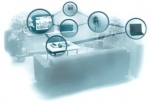
In AmI spaces these systems will proactively undertake speculative or anticipatory actions to hide the overall system complexity, by delivering to the users only information which is rich with meanings and contexts and provide stable functionality whenever requested
This article by Wayt Gibbs, recently published on Scientific American, show how engineers are testing computers, phones and cars that sense when you are busy and spare you from distractions...
More to explore
Attentive User Interfaces. Special section. Edited by Roel Vertegaal in Communications of the ACM, Vol. 46, No. 3, pages 30–72; March 2003.
Learning and Reasoning about Interruption. Eric Horvitz and Johnson Apacible. Proceedings of the Fifth International Conference on Multimodal Interfaces, November 2003. Proceedings of the International Workshop on Progress and Future Directions of Adaptive Driver Assistance Research. Washington, D.C., May 2004. Available online at www.volpe.dot.gov/opsad/saveit/
A variety of relevant technical articles are available online at http://interruptions.net
11:15 Posted in Pervasive computing | Permalink | Comments (0) | Tags: Positive Technology, Ambient intelligence
VR for PTSD rehabilitation in Israel
From Israel21c, "A focus beyond conflict"
Watching it - in three dimensions and full sound while wearing a head-mounted display helmet -may help hundreds of Israelis who have witnessed real terror attacks overcome post-traumatic stress disorder (PTSD), and is the basis of a new therapy for treating particularly resistant cases of PTSD.

The treatment is just one of dozens of novel applications of virtual reality (VR) technology which were demonstrated recently at the University of Haifa during the Third VR Symposium. Weiss, the person who brought together many of the world's leading VR wizards - and who is herself involved in several cutting edge VR applications, is a strictly observant Israeli who lives in the ultra-Orthodox neighborhood of B'nai Brak.

"It's not exactly normal," admits Weiss to ISRAEL21c, laughing at the contrast between her traditional way of life and the 'Brave New World' that characterizes her professional pursuits.
But Weiss sees no contradiction between the two. "I have always been interested in different technologies and my goal has always been to help people," says the researcher, whose library has volumes of Psalms and kinesiology textbooks side by side.
An occupational therapist by training, Weiss grew up in Canada and taught at McGill University in Montreal for many years, before immigrating to Israel in 1991 with her Israel-born husband. For the last four years she has been a researcher and lecturer at the University of Haifa, and a member of its newly-established Laboratory for Innovations in Rehabilitation Technology.
Weiss's interest in VR was piqued when she read an article by one of the pioneers in the field, Prof. Albert 'Skip' Rizzo of the University of Southern California, nearly a decade ago. That ultimately led to a close collaboration with Rizzo, who also attended this month's symposium.
What interests her about the field? "Look at this," says Weiss, showing a videotape of a woman with a spinal cord injury doing traditional physiotherapy. The therapist hands her a plastic ring which she must grasp without losing her balance - then another ring, and another, and another. "Let's face it. It's very static and very boring."
Now she shows a videotape of another patient who is also learning to balance himself - only he is watching himself on a giant screen, against a breath-taking mountain backdrop, swatting at balls in the sky. Every ball he hits turns into a colourful bird. The scene is virtual, but the man's movements - he is leaping and swatting with increasing determination - are very real.
"It's interesting and motivating," explains Weiss. "I have yet to meet a patient - of any age - who didn't like it. So it's very effective." (In a newer version, she notes excitedly, patients will wear a glove which vibrates whenever they make contact with a virtual ball - further increasing the sense of realness.)
The symposium Weiss organized, which brought leading VR experts from the US, Canada, Europe, Japan and Israel, to Haifa showed the dizzying range of new VR technologies dedicated to health and rehabilitation - from a robotic dog, who can be a reliable companion for the elderly - "no need to feed him or take him for walks," noted the researcher who demonstrated the small, black, yelping Sony invention - to 3D interactive games that could some day be used for early diagnoses of Alzheimer's disease, treatment of attention deficit disorder, and rehabilitation of patients who have suffered central nervous system injuries.
"Virtual reality has completely revolutionized the field of occupational therapy," says Weiss, who is personally involved in several innovative VR projects, including the simulated bus bombing program designed to treat Israelis suffering from severe post-traumatic stress.
That program - developed together with Dr. Naomi Josman, Prof.Eli Somer and Ayelet Reisberg, all of the University of Haifa, as well as with American researchers - is designed to expose patients in a controlled manner to the traumatic incident which they are often unable to remember, but which has a powerful and debilitating effect on their lives.
The realistic rendering of the bus bombing triggers the patient's memories - the first vital step on the path to overcoming trauma. (The simulation does not include all the gruesome details of the attack, but rather just enough to help the patient recall what happened.)
It was Josman who first came up with the idea of using such a treatment in Israel. She was attending a conference in the United States when she saw how University of Washington Prof. Hunter Hoffman had applied VR to successfully treat Americans suffering from PTSD following the 9/11 attack on the Twin Towers.
Similar programs have also been used recently to help American veterans traumatized by their tour of duty in Iraq, and even Vietnam veterans for whom no other treatment has proven effective.
Through close collaboration with Hoffman, the U. of Haifa team developed an Israeli version of the program which is now being used to treat the first few patients.
"If our pilot study is effective, we will launch a full-scale clinical trial," says Weiss, "and hopefully we will be able to provide a solution for those PTSD patients who have been resistant to more traditional cognitive therapy."
In another application of VR technology, Weiss and U. of Haifa colleagues have developed a program to help stroke victims relearn the basic skills required to shop on their own. The patient composes a grocery list and makes his or her way through a 'virtual supermarket,' seeking the right products, pulling them off the shelves and into a shopping cart, while announcements of sales are broadcast on the loudspeaker system.
"It's the first such program designed to improve both cognitive and motor skills of stroke victims," she notes.
Last week, the American Occupational Therapy Foundation (AOTF) invited Weiss to join its Academy of Research, the highest scholarly honor that the AOTF confers.
"Your work clearly helps to move the profession ahead, and demonstrates powerful evidence of the importance of assistive technology in helping persons with disabilities participate in the occupations of their choice, while improving the quality of their lives," the AOTF wrote in its letter to Weiss.
For Weiss, virtual reality is not only the focus of research, but a way of life - at least in her work. She communicates with her colleagues around the world by tele-conference and, of course, email - and notes that she has never even met her close collaborator Hoffman even though they have been
communicating several times a week for years. She also taught an entire university course last semester - without ever attending a lecture hall. Instead, she sat in the comfort of her B'nai Brak home, wearing a headset and microphone to deliver a weekly videoconferenced lesson on assistance technology to students who sat in their own homes.
"They could see a video of me, and whenever a student wanted to speak I would see the icon of a hand being raised. We even had guest lecturers from abroad. The students really appreciated not having to come to the university late at night for the course," says Weiss, who was pleased to be able to - once again - harness technology to help make people's lives a little easier.
10:30 Posted in Cybertherapy | Permalink | Comments (0) | Tags: Positive Technology, virtual reality, cybertherapy
Mar 22, 2005
Virtual reality games alleviate pain in children
From BioMed Central
Immersion in a virtual world of monsters and aliens helps children feel less pain during the treatment of severe injuries such as burns, according to a preliminary study by Karen Grimmer and colleagues from the Women's and Children's Hospital in Adelaide, Australia.

A virtual reality game is a computer game especially designed to completely immerse the user in a simulated environment. Unlike other computer games, the game is played wearing a special headset with two small computer screens and a special sensor, which allows the player to interact with the game and feel a part of its almost dreamlike world. "Owing to its ability to allow the user to immerse and interact with the artificial environment that he/she can visualize, the game-playing experience is engrossing", explain the authors.
Children with severe burns suffer great pain and emotional trauma, especially during the cleaning and dressing of their wounds. They are usually given strong painkiller drugs, muscle relaxants or sedatives, but these are often not enough to completely alleviate pain and anxiety. These medications also have side effects such as drowsiness, nausea or lack of energy.
Grimmer and colleagues asked seven children, aged five to eighteen, to play a virtual reality game while their dressing was being changed. The children were also given the usual amount of painkillers. The researchers assessed the pain the children felt when they were playing and then compared it to the amount of pain felt when painkillers were used alone.
To measure the intensity of the pain, the team used the Faces Scale, which attributes a score from 0 to 10, wherein 10 represents maximum pain, to a facial manifestation of pain. For younger children they used 5 different faces representing no pain to very bad pain. The researchers also interviewed the nurses and parents present during the dressing change.
The average pain score when the children received painkillers alone was 4.1/10. It decreased to 1.3/10 when the children had played a game and been given painkillers. Because the sample size was so small the researchers analysed their results per child, and they found that all but one child lost at least 2 points on the scale when they were playing the game. The parents and nurses confirmed these results and said that the children clearly showed less signs of pain when they played the game.
"We found that virtual reality coupled with analgesics was significantly more effective in reducing pain responses in children than analgesic only" conclude the authors.
This is only a preliminary study, but the researchers are hopeful. They propose to test virtual reality on more subjects, possibly with games appropriate to each age group, in the hope that it could one day greatly reduce, if not completely replace, the use of painkillers.
This press release is based on the article:
The efficacy of playing a virtual reality game in modulating pain for children with acute burn injuries: A single blinded randomized controlled trial Debashish Das, Karen Grimmer, Tony Sparnon, Sarah McRae, Bruce Thomas BMC Pediatrics 2005 4:27 (3 March 2005)
19:30 Posted in Cybertherapy | Permalink | Comments (0) | Tags: virtual reality, cybertherapy
Mar 18, 2005
Does medical technology really help doctors?
From WIRED
By Kristen Philipkoski
Nevertheless, the Centers for Medicare & Medicaid Services, or CMS, which provides health insurance to seniors and the poor, is giving a few technologies a shot at improving the government organization's dismal track record managing patients with chronic conditions.
Medicare's history of not adequately covering preventive health services has created a culture of patients waiting until things get really bad before they'll head to the hospital. Such acute care is far more expensive than the ongoing maintenance that can fend off emergencies in the first place.
As part of the Medicare Modernization Act of 2003, CMS is sponsoring nine pilot projects involving 180,000 patients and using technologies administrators hope will improve preventive care. Officials anticipate that the program could, for example, help a diabetes patient get to the doctor before she requires a leg amputation, or allow a doctor to begin a new prescription or diet before his patient suffers heart failure.
How expensive is chronic care? Two-thirds of Medicare money ($236.5 billion in 2001) is spent on just 20 percent of those enrolled, according to a 2002 report (.pdf) from Partnership for Solutions, a group that studies chronic health conditions. Everyone in that 20 percent is coping with five or more chronic conditions. The first of the baby boomers officially become seniors in 2011, and it is clear Medicare needs help, particularly in its chronic-care approach.
"This needs to happen anyway," said Sandy Foote, senior adviser for the Chronic Care Improvement Program at CMS.

CMS has chosen patients with chronic-care needs to participate in pilot projects that will implement technologies ranging from automated phone reminder systems and interactive in-home devices that ask patients questions about their health to hospital technologies for physicians.
CMS is paying health-management organizations like McKesson and Health Dialog to deliver technologies to those patients. But if after three years Medicare doesn't see a substantial improvement in health benefits and costs compared to a randomly selected group of about 100,000 control patients, CMS will ask for an unspecified portion of the fees back.
"We're not going to lock into a technology that may very well be outdated soon," Foote said. "We're paying organizations to help people in very individualized, very personalized ways to reduce their health risks, and they can keep refining how they do that."
That means, for example, McKesson is also not bound by the technologies it has chosen to implement. If something looks like it's not benefiting -- or actually is hindering -- patients or physicians, McKesson or any of the other management organizations can nix a technology for one that might work better.
The program sets up an exceptional potential for change and innovation in a hefty, bureaucratic government organization. And recent studies showing the failure of some medical technologies suggest that flexibility might be a good thing.
Two studies published in the March 9 issue of the Journal of the American Medical Association found that technologies designed to make physicians' jobs easier sometimes didn't, and in some cases the tools actually made the doctors' work more difficult.
"The system should not control the process of doing medicine but respond to how the hospital works," said the University of Pennsylvania's Dr. Ross Koppel, the lead author of the JAMA study. "Very often the software designers expect the users to wrap themselves like pretzels around the software, rather than making it respond to the hospital's needs."
18:05 Posted in Cybertherapy | Permalink | Comments (0) | Tags: Positive Technology, telemedicine
Feb 28, 2005
Virtual-Reality Movies Put a New Face on "User-Friendly"
FROM THE PRESENCE-L LISTSERV: (From UB News, the news service of the University of Buffalo)
Virtual-Reality Movies Put a New Face on "User-Friendly"
Intense psychological drama requires computer agents to be "more human"
Release date: Thursday, February 24, 2005
These improvisational computer agents are expected to influence the development of electronic devices of tomorrow, making them much more user-friendly because they will be able to respond to the idiosyncratic needs of each user.
The researchers' virtual-reality drama, The Trial The Trail, is a brand new type of dramatic entertainment, where instead of identifying with the protagonist, the audience becomes the protagonist.
The multidisciplinary team formed two years ago when Josephine Anstey, assistant professor in the Department of Media Study in the UB College of Arts and Sciences, was looking for ways to make VR dramas more believable. At the same time, Stuart C. Shapiro, Ph.D., professor in the Department of Computer Science and Engineering in the UB School of Engineering and Applied Sciences, was seeking applications to challenge the computerized cognitive agent called CASSIE that he and his colleagues had developed.
"We started thinking, 'What happens if you put a powerful artificial intelligence system -- which is what Stu has developed -- together with drama and stories?'" recalls Anstey. "The potential seems endless. You can get to the point where you have virtual characters that can believably respond to humans in real-time."
Instead of sitting in a darkened theater and passively watching a story unfold, human audience members in this interactive drama stand up, don gloves and headgear and become immersed virtually in the world of the characters on the screen.
Instead of using a joystick to compete against virtual characters as in a video game, the actions and utterances of human users determine how the virtual characters respond, based on an ever- growing "library" of actions and verbal communications with which the VR characters are endowed.
"Because of these attributes, we are creating a more intense psychological drama for users," said Anstey. "We are creating characters that are more similar to those you'd find in a novel."
The UB team fully explored these concepts in a paper presented last year entitled "Psycho-Drama in VR."
By necessity, added Shapiro, those characters are computational agents that must be capable of behaving in sophisticated and very human-like ways, attributes that also can help take "user- friendliness" for computers and other electronic devices to new heights.
"This is a step in the design and implementation of computer agents that are aware of themselves and their actions, as well as the environment they are in," he explained, "so this work is relevant to any application in which people interact with a device or system."
Shapiro referred to the team's approach toward its virtual characters as "cognitively realistic."
"We use a kind of computational 'self-perception' so that just the way that hearing people can pace their speech more effectively than deaf people, here's an agent that 'hears' computationally and can respond to what's happening," he explained. "The agent has some perception of itself and some level of self-awareness."
While other computer scientists are exploring multiple agent systems, he continued, this project is more demanding because the agents in the drama must be able to "perceive" themselves and then respond to the user.
So, as the human user proceeds through the drama, his or her actions are being recorded computationally over the Internet, interpreted psychologically and used to prompt the responses by the virtual characters.
In a sense, the computational agents in the drama must improvise around the human user, who is acting spontaneously without a script.
This, Anstey says, is a grand departure from the way that humans experience other types of computational dramas, such as video games.
"Very few computer games' characters have psychological lives that you can respond to," she says.
Because of this, the drama is different every time, a factor that the researchers say is both a more challenging and exciting type of entertainment, while also more computationally demanding.
In the UB drama, the main VR character is a dramatic representation of CASSIE, the cognitive agent, based on SNePS, Semantic Network Processing System, a knowledge- representation system developed over the past several decades by Shapiro and William Rapaport, Ph.D., UB associate professor of computer science, and scores of UB graduate students.
SNePS endows a computational agent with the ability to perform reasoning tasks, make inferences and do belief revision, where it can correct itself if it obtains additional information that indicates that it was misled initially.
"Cassie is one of the few intelligent agents that can process and communicate in natural language," said Shapiro. "You can talk to her in English."
He explained that one SNePS runs for each agent in the drama, and they are learning to communicate and interfere with one another.
"For computer-based fiction to really emerge, there has to be a lot of work using intelligent agents," said Anstey. "Anybody interested in the fiction and drama of the future can't ignore this.
Writers will have to build these skills, will have to, in a way, think more like computer scientists."
In addition to Anstey and Shapiro, the UB team consists of David Pape, assistant professor in the Department of Media Study in the UB College of Arts and Sciences; Anthony Ekeh, a graduate student in computational linguistics; Michael Kandefer, a doctoral candidate, and Trupti Devdas Nayak, a graduate student, both in the Department of Computer Science and Engineering, and Orkan Telhan, a graduate student in media study.
Contact: Ellen Goldbaum, goldbaum@buffalo.edu
Phone: 716-645-5000 ext 1415
Fax: 716-645-3765
16:35 Posted in Cybertherapy | Permalink | Comments (0) | Tags: virtual reality therapy
Feb 11, 2005
Congress on Virtual Reality Appications - CARVI 2005
9th and 10th of June * Vitoria-Gasteiz (Spain)
EUVE Technological Center specialised in Virtual Reality, Virtual Engineering and Hidrometeorology is pleased to announce you the 3rd edition of the International Congress in Virtual Reality Applications where the last advances in Research and Development in applied Virtual Reality will be show. Besides CARVI 2005 will be a meeting point among researchers, companies and users.
The topics of CARVI2005 will be about the Virtual Reality Applications on:
- Product design and manufacturing processes.
- Architecture, Culture and Archaeology.
- Virtual Reality in Scientific Applications.
- Television, films and advertising.
- Simulation, coaching and trainning.
- New tools, new technologies.
The deadlines for the publication of projects or research lines are:
Abstract due date: March the 8th 2005
Accetance notice: March the 16th 2005
Full paper due date: April the 26th 2005
All the information related to the Congress can be found at CARVI web site
15:36 Posted in Positive Technology events | Permalink | Comments (0)
Cibex-Trazer VR system for neurorehabilitation
Retrieved from: the PRESENCE - Listserve
It may sound like science fiction, but it’s exactly what Bob Verdun, the new director of the Pawtucket Family YMCA, wants to achieve with a cutting-edge piece of fitness equipment called the Trazer.
The Trazer is a serious machine, using optical sensors, an electronic "beacon," and interactive, virtual reality software to facilitate exercise training, sports testing and rehabilitation -- but Verdun is more interested in its kid-appeal.
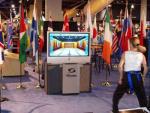
That’s because the Trazer is the fitness equivalent of the nutritious Twinkie: A virtual reality video game designed to make excise universally accessible and, believe it or not, fun.
"There is a resistance for kids who are not good at team sports to join a school team, and these are usually the kids who need exercise the most," said Ray Giannelli, the senior vice president of research and development for Cybex International, the Massachusetts-based company that will ship three of the first production Trazers to Pawtucket this spring.
The Trazer, said Giannelli, will give sports-adverse kids a fighting chance to stay in shape by putting simple, effective exercises within the familiar context of a video game.
"A lot of kids today are on the computer all day, e-mailing or chatting or playing video games," said Verdun, "This is the perfect bridge to exercise, a viable way to win the war against childhood obesity."
Here’s how it works:
Optical sensors mounted beneath a sleek, high-definition video display are trained to register the movements of an electronic beacon in a 6-foot, three-dimensional space.
When the beacon is attached to a belt worn by the user, his or her movements are mimicked in real-time by a virtual character in a virtual world.
An easy-to-navigate options menu features interactive programs for performance testing and sports training, as well as rehabilitative movement therapy, kinesthetic learning and fitness fun.
There are programs designed for the elderly to help them strengthen neglected muscles and maintain a full range of motion, and games designed to keep kids excited about physical activity.
In one game called "Trap Attack," players are required to move their virtual self across a three-dimensional chessboard, in sync with a roving red cursor.
Play the game on a basic difficulty setting, and the cursor moves relatively slowly, one square at a time. Crank up the difficulty, and trapdoors will appear, forcing you to jump over them.
Another game, "Goalie Wars," allows the player to intercept and "catch" soccer balls thrown by a virtual goalie. Once caught, a ball can be thrown back by lunging forward, and if you fake-out your polygonal opponent, you score a point.
Although optical sensors and virtual reality video games are impressive, they’re not exactly new.
The real meat and potatoes of Trazer is its ability to analyze and tabulate the data it collects. While you play "Goalie Wars" or "Trap Attack," the Trazer is measuring your reaction time, acceleration, speed, power, balance, agility, jumping height, endurance, heart rate and caloric output.
These statistics are displayed and saved after the completion of each exercise, a feature which will allows serious athletes, convalescents and kids to quantify their performance and track their progress.
As they’re fond of saying at Cybex, Trazer has more in common with a flight simulator than an exercise machine.
The Trazer is a versatile exercise machine, but Verdun and his colleagues are hoping it will be a crowd-pleaser as well.
Although the Trazer is still in development, a video demonstration of its capabilities and a hands-on demonstration of the more conventional Cybex Arc Trainer -- a high-tech step- machine -- are expected to be the main attractions at the YMCA’s open house on Saturday.
Scheduled for Saturday, from 10 a.m. to 12 p.m., the open house is a sneak preview: a way to show current and prospective members what they can expect from the Y’s $8 million facelift -- a soup-to-nuts overhaul which will include renovated facilities, expanded program space and brand-new, state-of-the-art fitness equipment.
The ultimate goal is to make the YMCA more family-friendly and appeal to old people, young people and everyone in between. To Verdun’s thinking, what better way to bring the 115-year-old building into the realm of iPods and Instant Messages than a video game.
"We want parents and children to know that there isn’t anything they can’t do at our facility," Verdun said in a recent interview.
"Families can come here, exercise together, and share an experience that is affordable, safe and fun.
"You don’t think about moving around when you’re on the Trazer, and that’s exactly what we want. The essence of the YMCA is having fun."
15:30 Posted in Cybertherapy | Permalink | Comments (0) | Tags: Positive Technology, virtual reality
Feb 10, 2005
Cyberart Festival
The Boston Cyberarts Festival is an international biennial festival of art and technology in all media. The next Festival will take place April 22 through May 8, 2005. It will include visual and performing arts and explore how artists throughout the world are using computers to advance traditional artistic disciplines and create new interactive worlds.
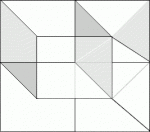
The 2005 Festival will also feature two conferences during the opening weekend: eMerging Arts and Technologies, for artists and high-tech company professionals; and Ideas in Motion, focused on innovations in dance, movement, and technology.
13:46 Posted in Cyberart | Permalink | Comments (0)
Speaking with objects
The art and soul of a new machine
by Missy Sullivan, Forbes Magazine, 09.20.99
Did you ever notice how a chicken wishbone, turned upside down, looks remarkably like a bowlegged cowboy in chaps? Ever imagine a cloud gliding down from the sky bearing gifts? C'mon, admit it. In some idiotic moment of utter boredom you have fantasized about blowing something up.
For most people, these are idle thoughts. But reveries like these are what inspired sculptor, inventor and award-winning toy designer Arthur Ganson, 44, to create his wondrous machines.
He had that wishbone epiphany. It's embodied in a clattering contraption of wires, gears and pulleys that makes a chicken wishbone swagger like a miniature John Wayne. The cloud fantasy? On their first anniversary his wife looked up to see a tray of chocolate and sake descending on a mechanical cloud that he was diligently lowering from the ceiling.

You can see the outcome of Ganson's big-kaboom dream for yourself on your next trip to Boston. Just head over to his exhibition at the Massachusetts Institute of Technology Museum--he's an artist-in-residence at the school--where a wildly popular machine repeatedly blows up and reconfigures a miniature yellow chair.
These are just a few of the fantastical creations from Ganson's studio outside of Boston. Frank Maresca, co-owner of the Ricco/Maresca Gallery in New York (where a Ganson sculpture goes for between $15,000 and $60,000), describes the studio as a cross between Santa's workshop and mission control for the moon launch.

This helps explain why Ganson has something of a cult following among local college students, some of whom return to the MIT exhibit 40 to 50 times. A comment in the visitors book from an even younger fan: "You're either a psycho or a genius, or both. Either way, you rule!"
But Ganson's machines are a lot more than just clever gadgets. The art part comes in the way his mechanical gestures so intuitively and eloquently convey human feelings. Wriggling inchworms, mincing feather dusters, Kabuki-dancing miniature plastic swords. Ganson's work celebrates life with a sense of wonderment and humor that's all too rare in the self-important world of contemporary art.
You can see it in the reactions to Ganson's work up at MIT. Eyes widen in front of torn-paper "wings" fluttering poignantly atop a forest of thin wire poles. And people actually blush before the machine that erotically spurts grease on itself.
One recent work, "Machine with Artichoke Petal," stands a dried-up little leaf atop a wheel, its curled tip perfectly evoking a dejected head. Set the wheel in motion and the schlumpy little guy starts trudging slowly along like Willy Loman after a bad sales day.
"It's astounding to me that someone can make a machine with such nuanced and complex emotional resonances," says Nicholas Capasso, curator of Ganson's first one-person museum show in 1993 at the DeCordova Museum & Sculpture Park in Lincoln, Mass. "Anyone can make a machine that waves, but only Arthur can make a machine that waves good-bye. There's a big difference."
About the artist
Arthur Ganson has been making kinetic sculpture for 27 years, having received a BFA from the University of New Hampshire in 1978. He has exhibited his machines in galleries and museums in the United States and Europe. A former artist-in-residence at the Massachusetts Institute of Technology, he maintains an ongoing exhibition of sculpture at the MIT Museum in Cambridge. Recently he appeared as a cartoon bear on the animated children's series "Arthur," and his friends say the likeness is remarkable. Ganson is the inventor of the award-winning children's toy Toobers and Zots. He lives and works near Boston. More work may be seen at his Web site, www.arthurganson.com.
13:38 Posted in Cyberart | Permalink | Comments (0)
Brain-imaging study on action observation and acquired motor skills
Earlier studies with monkeys revealed that brain cells called “mirror neurons” respond both when we do something, like pick up an object, and when we simply watch someone else do it. It was known that these neurons fire when we perform an action, but it was unexpected that the same cells also fired when we only saw that action being performed. This new study by Calvo-Merino and coll., recently published on the journal “Cerebral Cortex”, goes a step further by showing that such a system operates differently depending on what a person is physically expert at doing.
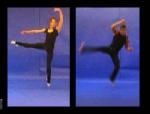
According to the authors of the experiment, this is the first proof that our personal motor repertoire - the things that we have learned to do - changes the way that our brain responds when we see the movement. In particular, these findings suggest that once the brain has learned a skill, it may simulate the skill without even moving, through simple observation: an injured dancer might be able to maintain his skill despite being temporarily unable to move, simply by watching others dance.
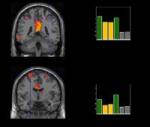
These results provide further support to the I-Learning Project clinical rationale, and justify the use of I-Learning technology to better rehabilitate people whose motor skills were damaged by stroke.
Reference: B. Calvo-Merino, D.E. Glaser, J. Grezes, R.E. Passingham and P. Haggard, Action Observation and Acquired Motor Skills: An fMRI Study with Expert Dancers, Cerebral Cortex, Dec. 2004
13:20 Posted in Mental practice & mental simulation | Permalink | Comments (0) | Tags: mental practice, motor imagery
Jan 28, 2005
VR to treat PTSD
From Wired
With a push of a button, special effects will appear -- a mosque's call to prayer, a sandstorm, the sounds of bullets or bombs. "We can put a person in a VR headset and have them walk down the streets of Baghdad," Rizzo said. "They can ride in a Humvee, fly in a helicopter over a battle scene or drive on a desert road."
This is no video game, nor is it a training device. Rizzo and colleagues are developing a psychological tool to treat post-traumatic stress disorder, or PTSD, by bringing soldiers back to the scenes that still haunt them. A similar simulation is in the works for victims of the World Trade Center attacks.
PTSD treatment, the newest frontier in the intersection between virtual reality and mental health, is one of the hot topics this week at the 13th annual Medicine Meets Virtual Reality conference, which began Wednesday in Long Beach, California. Rizzo and others will explore plans to expand virtual reality's role in mental health by adding more elements like touch and the ability to interact with simulations. "The driving vision is a holodeck," Rizzo said. "If you look at the holodeck, and all the things people do in Star Trek, that's what we'd like to be able to do."
Powerful computers are cheaper -- the necessary machines used to cost as much as $175,000 but now the Virtual Reality Medical Center in San Diego, one of about 10 private VR mental-health clinics in the United States, picks up its hardware at Fry's Electronics. VR helmets -- which allow users to turn their heads and see things above, below and behind them in the 360-degree virtual world -- cost as little as a few thousand dollars. And perhaps most importantly, the graphics are more advanced, thanks to partnerships with video-game developers.
At the San Diego clinic, graphics designers are developing a remarkably realistic virtual world based on digital photos and audio from San Diego International Airport. Patients afraid of flying will be able to take a virtual tour of the airport, from the drop-off area through the ticket counter, metal detectors and waiting areas. The simulation is so precise that users can enter restrooms, peruse magazines at the newsstand or wander around the food court; recordings will allow the virtual PA system to offer the requisite incomprehensible announcements.
The clinic already offers a simulation of a flight. At $120 a session, patients sit in actual airplane seats and watch a simulation of a takeoff, accurate all the way down to announcements by flight attendants and pilots. At takeoff, actual airplane audio -- engines revving, landing gear retracting -- is channeled into subwoofers below the seat, providing a dead-on simulation of what a passenger feels. Even the view outside the window is based on actual digital video from a flight.
"Exposure therapy" has long been a common treatment for phobias. "It's a gradual reversal of avoidance," said psychologist Hunter Hoffman, a researcher who studies VR at the University of Washington. "You start by having them hold their ground. A lot of phobics have mental misunderstandings about what would happen if they face the thing they're afraid of. A spider phobic, they may think they're going to have a heart attack -- they think if they don't leave the room, they'll go insane. They have these unrealistic theories about what will happen."
17:25 Posted in Cybertherapy | Permalink | Comments (0) | Tags: Positive Technology, virtual reality, cybertherapy
Jan 26, 2005
Second-generation VR headset
FROM THE PRESENCE-L LISTSERV:
From The East Valley (Arizona) Tribune
Tempe company has vision of future
By Ed Taylor, Tribune
Vincent F. Sollitto Jr. can’t be accused of lacking vision. The president and chief executive officer of Brillian Corp., a Tempe- based developer of high-definition televisions, sees a world in which millions of kids will play video games with sleek headsets that immerse them in a virtual reality world of their choosing — displaying bright, full-color, three-dimensional, high resolution scenes.

Best of all, the wireless headsets can be taken just about anywhere.
"This has medical and military applications, but gaming is the big market," Sollitto said. "Some day we’ll be producing millions of units a month. The kids are the real target."
Such technology is already here, but Brillian is trying to expand the market with an improved second-generation headset.
Brillian displayed a second generation prototype head-mounted display for video applications at the Consumer Electronics Show earlier this month in Las Vegas. The company is looking for partners that want to use the Brillian developed technology to bring their own head-mounted displays to the consumer market.
Already the company’s near-to-eye display technology is being used in headsets sold by i-O Display Systems and Shimadzu Corp.
The new second-generation version is intended to be leased to original equipment manufacturers that would put their own brand name on the product and bring it to the market quickly without having to design all of the technology pieces themselves, said Rainer Kuhn, vice president of sales and product marketing.
The headsets can plug into television sets, computers, DVD players, portable video recorders or game consoles. Another possibility is attaching them to mobile phones that can receive streaming video, providing an alternative to the tiny viewing screens on most cell phones. Miniature earphones can be attached to the headsets to provide audio.
The headset runs on a battery that provides 2 1 /2 to three hours of viewing. When combined with a player that also runs on batteries, consumers can take their programs wherever they want.
"Imagine sitting on an airplane and watching a movie privately at your seat," said Hope Frank, Brillian’s vice president of marketing.
The device demonstrated at the electronics show displays text, graphics, full motion video and 3-D content. The picture is equivalent to viewing a 42-inch diagonal television set from about
6 feet away, the company said.
Brillian makes the tiny microdisplay chips that go inside the headset at its Tempe headquarters, 1600 N. Desert Drive. The company also designed the electronics and optics for the system but outsources the manufacturing.
The design of the headsets will be key to making the product commercially successful, Frank said. The company has partnered with Ideo, an industrial design firm based in Palo Alto, Calif., to help.
"It’s not just the picture inside. It has to have the right weight and form factor," she said.
The prototype weighs about 4 ounces, making it lighter than displays currently on the market. Also it can fit over eyeglasses and has an adjustable headband for a comfortable fit.
"We think it’s not if, but when the market will take off with this,"
said Kuhn, adding that the second-generation technology could be available to consumers by the end of this year.
14:30 | Permalink | Comments (0)
Jan 20, 2005
Play scents like you play music!!
 disc themes to work much like a music CD player. Just insert one of the themed discs and push play. The player then rotates through five scents on each disc, one by one with a new scent every 30 minutes.
disc themes to work much like a music CD player. Just insert one of the themed discs and push play. The player then rotates through five scents on each disc, one by one with a new scent every 30 minutes.
The player shuts off automatically after all five scents have been played. You can stop the player or skip through the scent tracks at any time. Together, the Scentstories player and disc create a new-to-the-world scent experience.
Articles
"As Scentstories suggests, smell is the next big accessory for the home ... pop in a scented disc and go barefoot on the shore" The New York Times, August 5, 2004
"And now the latest entrant ... Scentstories from Procter & Gamble, an electric machine that amounts to a mini-jukebox of nice smells" USA Today, August 3, 2004
"We then sneak-sniffed the "Celebrate the Holidays" disc (the sixth disc, not on the market until October). Track 2, "baking holiday pie" was this tester's fave overall." The Chicago Tribune, August 15, 2004
"Smoky candles aren't exactly office-friendly. So what's a girl to do when she craves a Zen like moment on the job? Enter Febreze Scentstories. Discs you slip into a boom box-like gadget for two-plus hours of varying scents like lavender or vanilla. "I love that you can adjust the intensity so the smell isn't overwhelming" one relaxed tester comments" Self magazine, September 2004
14:45 Posted in Cybertherapy | Permalink | Comments (0) | Tags: Positive Technology, virtual reality






